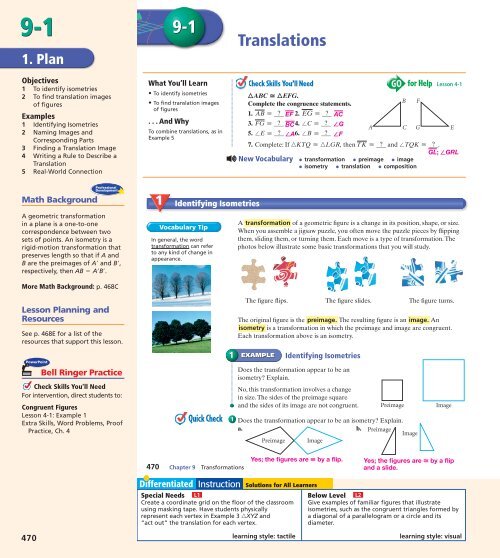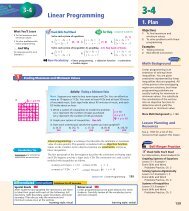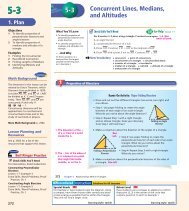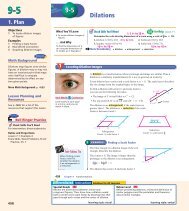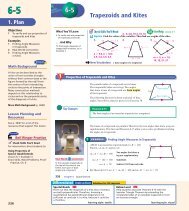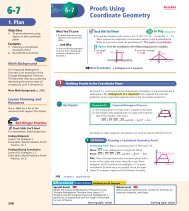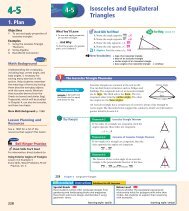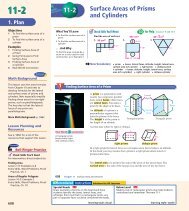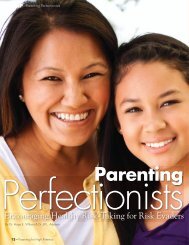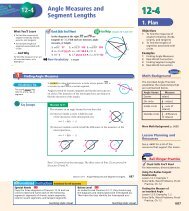Section 9.1
Section 9.1
Section 9.1
You also want an ePaper? Increase the reach of your titles
YUMPU automatically turns print PDFs into web optimized ePapers that Google loves.
9-1<br />
1. Plan<br />
Objectives<br />
1 To identify isometries<br />
2 To find translation images<br />
of figures<br />
Examples<br />
1 Identifying Isometries<br />
2 Naming Images and<br />
Corresponding Parts<br />
3 Finding a Translation Image<br />
4 Writing a Rule to Describe a<br />
Translation<br />
5 Real-World Connection<br />
Math Background<br />
A geometric transformation<br />
in a plane is a one-to-one<br />
correspondence between two<br />
sets of points. An isometry is a<br />
rigid-motion transformation that<br />
preserves length so that if A and<br />
B are the preimages of A� and B�,<br />
respectively, then AB = A�B�.<br />
More Math Background: p. 468C<br />
Lesson Planning and<br />
Resources<br />
See p. 468E for a list of the<br />
resources that support this lesson.<br />
PowerPoint<br />
470<br />
Bell Ringer Practice<br />
Check Skills You’ll Need<br />
For intervention, direct students to:<br />
Congruent Figures<br />
Lesson 4-1: Example 1<br />
Extra Skills, Word Problems, Proof<br />
Practice, Ch. 4<br />
What You’ll Learn<br />
• To identify isometries<br />
• To find translation images<br />
of figures<br />
. . . And Why<br />
To combine translations, as in<br />
Example 5<br />
z<br />
9-1<br />
1 Identifying Isometries<br />
Vocabulary Tip<br />
In general, the word<br />
transformation can refer<br />
to any kind of change in<br />
appearance.<br />
Quick Check<br />
470 Chapter 9 Transformations<br />
1<br />
Translations<br />
Check Skills You’ll Need GO for Help<br />
kABC OkEFG.<br />
Complete the congruence statements.<br />
1. AB � 9 EF 2. EG � 9 AC<br />
B F<br />
3. FG � 9 BC4.<br />
&C � 9 lG<br />
5. &E � 9 lA6.<br />
&B � 9 lF<br />
A C G<br />
7. Complete: If nKTQ � nLGR, then TK � 9 and &TQK � 9.<br />
New Vocabulary • transformation • preimage • image<br />
• isometry • translation • composition<br />
Lesson 4-1<br />
A transformation of a geometric figure is a change in its position, shape, or size.<br />
When you assemble a jigsaw puzzle, you often move the puzzle pieces by flipping<br />
them, sliding them, or turning them. Each move is a type of transformation. The<br />
photos below illustrate some basic transformations that you will study.<br />
The figure flips. The figure slides. The figure turns.<br />
The original figure is the preimage. The resulting figure is an image. An<br />
isometry is a transformation in which the preimage and image are congruent.<br />
Each transformation above is an isometry.<br />
EXAMPLE<br />
Special Needs L1<br />
Create a coordinate grid on the floor of the classroom<br />
using masking tape. Have students physically<br />
represent each vertex in Example 3 �XYZ and<br />
“act out” the translation for each vertex.<br />
Identifying Isometries<br />
Does the transformation appear to be an<br />
isometry? Explain.<br />
No, this transformation involves a change<br />
in size. The sides of the preimage square<br />
and the sides of its image are not congruent.<br />
Preimage Image<br />
1 Does the transformation appear to be an isometry? Explain.<br />
a. b. Preimage<br />
Image<br />
Preimage Image<br />
E<br />
GL;<br />
lGRL<br />
Yes; the figures are O by a flip. Yes; the figures are O by a flip<br />
and a slide.<br />
Below Level L2<br />
Give examples of familiar figures that illustrate<br />
isometries, such as the congruent triangles formed by<br />
a diagonal of a parallelogram or a circle and its<br />
diameter.<br />
learning style: tactile learning style: visual
Vocabulary Tip<br />
Read K S K9 as<br />
“K maps onto K prime.”<br />
Quick Check<br />
12 Translations<br />
Real-World<br />
Connection<br />
It is easier to check parts<br />
when each is a translation<br />
image of the others.<br />
Quick Check<br />
2<br />
2<br />
3<br />
A transformation maps a figure onto its image and<br />
may be described with arrow (S) notation. Prime (9)<br />
notation is sometimes used to identify image points. In<br />
the diagram at the right, K9 is the image of K (K S K9).<br />
Notice that you list corresponding points of the preimage and image in the same<br />
order, as you do for corresponding points of congruent or similar figures.<br />
EXAMPLE<br />
Naming Images and Corresponding Parts<br />
In the diagram, E9F9G9H9 is an image of EFGH.<br />
a. Name the images of &F and &H.<br />
&F9 is the image of &F.<br />
&H9 is the image of &H.<br />
b. List all pairs of corresponding sides.<br />
EF and ErFr; FG and FrGr;<br />
EH and ErHr; GH and GrHr<br />
In the diagram, NID S SUP.<br />
a. Name the images of &I and point D.<br />
b. List all pairs of corresponding sides.<br />
NI and SU;<br />
ID and UP;<br />
ND and SP<br />
A translation (or slide) is an isometry that maps all points<br />
of a figure the same distance in the same direction. The<br />
diagram at the right shows a translation of the black square<br />
by 4 units right and 2 units down. Using variables, you can<br />
say that each (x, y) pair in the original figure is mapped to<br />
(x + 4, y - 2).<br />
EXAMPLE<br />
Advanced Learners L4<br />
After students read about the composition of<br />
transformations, have them investigate whether the<br />
composition of translations is commutative.<br />
lU; P<br />
Finding a Translation Image<br />
Find the image of #XYZ under the translation<br />
(x, y) S (x - 2, y - 5).<br />
Use the rule to find each vertex in the translated image.<br />
X(2, 1) translates to (2 - 2, 1 - 5), or X9(0, -4).<br />
Y(3, 3) translates to (3 - 2, 3 - 5), or Y9(1, -2).<br />
Z(-1, 3) translates to (-1 - 2, 3 - 5), or Z9(-3, -2).<br />
The image of #XYZ is #X9Y9Z9 with X9(0, -4),<br />
Y9(1, -2), and Z9(-3, -2).<br />
G�<br />
H�<br />
E�<br />
F<br />
G<br />
H<br />
E<br />
EFGH E�F�G�H�<br />
N P<br />
I<br />
A B y<br />
D<br />
2<br />
C<br />
A� B�<br />
x<br />
�2 O<br />
D�<br />
�2<br />
2<br />
C�<br />
3 Find the image of #XYZ for the translation (x, y) S (x - 4, y + 1).<br />
X9(–2, 2), Y9(–1, 4), Z9(–5, 4)<br />
Lesson 9-1 Translations 471<br />
learning style: verbal<br />
S<br />
J<br />
F�<br />
U<br />
K<br />
Z<br />
D<br />
y<br />
Y<br />
1<br />
O X x<br />
�4 �2<br />
Z�<br />
2<br />
�1<br />
Y�<br />
4<br />
X�<br />
K�<br />
J�<br />
Q<br />
Q�<br />
�JKQ �J�K�Q�<br />
�JKQ maps onto �J�K�Q�.<br />
English Language Learners ELL<br />
Have students fill half a poster with definitions and<br />
illustrations of the new vocabulary, leaving room to<br />
add more vocabulary from subsequent lessons.<br />
Students can refer to the poster as needed.<br />
learning style: tactile<br />
2. Teach<br />
Guided Instruction<br />
1<br />
EXAMPLE<br />
Teaching Tip<br />
Ask: What do you call figures<br />
whose corresponding angles are<br />
congruent and whose corresponding<br />
sides are proportional?<br />
similar<br />
PowerPoint<br />
Additional Examples<br />
1 Does the transformation<br />
appear to be an isometry? Explain.<br />
Yes; corresponding parts appear<br />
to be congruent.<br />
2 In the diagram, �XYZ is an<br />
image of �ABC.<br />
C Z<br />
B<br />
A<br />
Preimage<br />
Image<br />
a. Name the images of &B and<br />
&C. lY and lZ<br />
b. List all pairs of corresponding<br />
sides. AB and XY;<br />
AC and XZ;<br />
BC and YZ<br />
3 Find the image of �ABC under<br />
the translation (x, y) S (x + 3,<br />
y - 1).<br />
A<br />
5 y<br />
4<br />
A�<br />
3<br />
C<br />
2<br />
1<br />
C� x<br />
�5�4�3�2�1 0<br />
�1<br />
B<br />
�2<br />
B�<br />
�3<br />
1 2 3<br />
A�(0, 3), B�(–1, –2), C�(1, 0)<br />
X<br />
Y<br />
471
5<br />
EXAMPLE<br />
Ask: Why is a negative number<br />
used for Yolanda’s walk west?<br />
Vectors represent distance and<br />
direction, and left and down both<br />
are negative directions on a<br />
coordinate grid.<br />
PowerPoint<br />
Additional Examples<br />
4 Write a rule to describe the<br />
translation �ABC S �A�B�C�.<br />
B<br />
4<br />
3<br />
2<br />
y<br />
B'<br />
A<br />
1<br />
C<br />
�3�2�1 A'<br />
1 2 3 4 x<br />
�2<br />
�3<br />
�4<br />
C'<br />
(x, y) S (x ± 6, y –1)<br />
5 Tritt rides his bicycle 3 blocks<br />
north and 5 blocks east of a<br />
pharmacy to deliver a prescription.<br />
Then he rides 4 blocks south and<br />
8 blocks west to make a second<br />
delivery. How many blocks is he<br />
now from the pharmacy? 1 block<br />
south and 3 blocks west<br />
Resources<br />
• Daily Notetaking Guide 9-1 L3<br />
• Daily Notetaking Guide 9-1—<br />
Adapted Instruction L1<br />
Closure<br />
Write a rule to describe the<br />
translation �GHI S �G�H�I�. Then<br />
find the image �G�H�I� of �G�H�I�<br />
under the translation (x, y) S<br />
�x + 8, y + 6�.<br />
6<br />
5<br />
4<br />
y<br />
H<br />
3<br />
H'<br />
2<br />
1<br />
I<br />
G<br />
�4�3�2�1 �1<br />
�2<br />
I'<br />
�3<br />
1 2<br />
G'<br />
3 4 5 6x<br />
rule: (x, y) S (x – 5, y – 4);<br />
kG�H�I� with vertices G�(9, 5),<br />
H�(8, 8), and I�(5, 4)<br />
472<br />
CABLE CAR<br />
BARN MUSEUM<br />
Quick Check<br />
Downtown San Francisco<br />
MASON ST.<br />
UNION SQUARE<br />
WELLS FARGO<br />
HISTORY MUSEUM<br />
CALIFORNIA ST.<br />
POST ST.<br />
MARKET ST.<br />
Quick Check<br />
472 Chapter 9 Transformations<br />
4. a. Answers may vary.<br />
Sample: lQ S lQr<br />
b. QR and QrRr;<br />
RS and<br />
RrSr;<br />
SP and SrPr;<br />
QP and QrPr<br />
MONTGOMERY ST.<br />
4<br />
4<br />
5<br />
EXAMPLE<br />
Writing a Rule to Describe a Translation<br />
Write a rule to describe the translation<br />
PQRS S P9Q9R9S9.<br />
Use P(-1, -2) and its image P9(-5, -1).<br />
Horizontal change: -5 - (-1) =-4<br />
Vertical change: -1 - (-2) = 1<br />
The rule is (x, y) S (x - 4, y + 1).<br />
The translation image of #LMN is<br />
#L9M9N9 with L9(1, -2), M9(3, -4), N9(6, -2).<br />
Write a rule to describe the translation.<br />
(x, y) S (x ± 7, y – 1)<br />
A composition of transformations is a combination<br />
of two or more transformations. In a composition,<br />
each transformation is performed on the image of<br />
the preceding transformation.<br />
In a knight’s move on a chessboard, the translation<br />
indicated in blue is the composition of two translations<br />
indicated in red.<br />
In general, the composition of any two translations<br />
is a translation.<br />
EXAMPLE Real-World Connection<br />
O y x<br />
�6 �4<br />
L<br />
�2<br />
N<br />
2<br />
Tourism Yolanda Perez is visiting San Francisco. From her hotel near Union<br />
Square, she walks 4 blocks east and 4 blocks north to the Wells Fargo History<br />
Museum to see a stagecoach and relics of the Gold Rush. Then she walks 5 blocks<br />
west and 3 blocks north to the Cable Car Barn Museum. Now how many blocks<br />
is she from her hotel?<br />
Use (0, 0) to represent Yolanda’s hotel.<br />
(x, y) S (x + 4, y + 4) represents a walk of 4 blocks east and 4 blocks north.<br />
(x, y) S (x - 5, y + 3) represents a walk of 5 blocks west and 3 blocks north.<br />
Yolanda’s current position is the composition of the two translations. First,<br />
(0, 0) translates to (0 + 4, 0 + 4) or (4, 4). Then,<br />
(4, 4) translates to (4 - 5, 4 + 3) or (-1, 7).<br />
Yolanda is 1 block west and 7 blocks north of her hotel.<br />
5 Yolanda next walks to a restaurant 2 blocks east and 4 blocks south of the<br />
Cable Car Barn Museum. Now how many blocks is she from her hotel?<br />
1 block east and 3 blocks north of her hotel<br />
5. a. Answers may vary.<br />
Sample: lR S lRr<br />
b. RI and RrIr;<br />
IT and<br />
IrTr;<br />
RT and RrTr<br />
Q�<br />
M<br />
y<br />
4<br />
R�<br />
Q R<br />
2<br />
O<br />
�4 �2<br />
4 x<br />
P�<br />
P<br />
S�<br />
S<br />
�3<br />
�3
EXERCISES<br />
For more exercises, see Extra Skill, Word Problem, and Proof Practice.<br />
Practice and Problem Solving<br />
A<br />
Practice by Example<br />
GO for<br />
Help<br />
Example 1<br />
(page 470)<br />
Example 2<br />
(page 471)<br />
6a. Answers may vary.<br />
Sample: GSM b. GW and MR;<br />
WP and RT;<br />
PN and TX;<br />
NB and XS;<br />
BG and SM<br />
Example 3<br />
(page 471)<br />
7. (–6, 5), (2, 4),<br />
(–3, 1)<br />
8. (1, –2), (4, 1),<br />
(10, –2), (7, –5)<br />
Example 4<br />
(page 472)<br />
State whether the transformation appears to be an isometry. Explain.<br />
1. Image 2. 3.<br />
Preimage<br />
Image<br />
Preimage<br />
Yes; the trans. is a slide.<br />
Preimage Image<br />
Yes; the trans.<br />
is a flip. No; the figures<br />
In each diagram, the blue figure is an image of the black figure.<br />
are not O.<br />
(a) Choose an angle or point from the preimage and name its image.<br />
(b) List all pairs of corresponding sides.<br />
4. 4–5.<br />
See margin.<br />
Q R 5. I�<br />
T�<br />
R� R 6. G<br />
P<br />
W R<br />
T<br />
M<br />
S� R�<br />
P� Q�<br />
Find the image of each figure under the given translation.<br />
7. (x, y) S (x + 3, y + 2) 8. (x, y) S (x + 5, y - 1)<br />
9. (x, y) S (x - 2, y + 5) 10. (x, y) S (x - 4, y + 3)<br />
�6 �2<br />
(–7, 5), (–7, 8), (–4, 8), (–1, 2) (–4, –0.5), (–1, 4), (5, 0), (–2, –3)<br />
In Exercises 11–14, the blue figure is a translation image of the red figure. Write a<br />
rule to describe each translation.<br />
11.<br />
4<br />
y<br />
12. y<br />
2<br />
�8 �6<br />
O<br />
�2<br />
x<br />
�2<br />
O 4<br />
�2<br />
P<br />
4<br />
2<br />
�3<br />
y<br />
O<br />
S<br />
2<br />
3<br />
�8 �4 �2 O<br />
(x, y) S (x ± 1, y – 3)<br />
x<br />
y<br />
x<br />
x<br />
T<br />
I<br />
�2<br />
O<br />
�2<br />
�4<br />
�6<br />
y<br />
1<br />
O<br />
�2<br />
y<br />
B N X S<br />
2<br />
4 8<br />
�4<br />
�6<br />
(x, y) S (x ± 1, y – 1)<br />
Lesson 9-1 Translations 473<br />
x<br />
x<br />
3. Practice<br />
Assignment Guide<br />
1<br />
2<br />
A B 1-6<br />
A B 7-34<br />
C Challenge 35-36<br />
Test Prep 37-41<br />
Mixed Review 42-46<br />
Homework Quick Check<br />
To check students’ understanding<br />
of key skills and concepts, go over<br />
Exercises 2, 8, 18, 26, 27.<br />
Error Prevention!<br />
Exercise 12 Suggest that students<br />
who are confused by overlapping<br />
figures focus on each vertex and<br />
its image separately.<br />
GPS<br />
Enrichment<br />
Guided Problem Solving<br />
Reteaching<br />
Adapted Practice<br />
Name Class Date<br />
Practice 9-1<br />
Write the tangent ratios for lE and lF.<br />
1. E<br />
2. F 5 D<br />
3. D<br />
4<br />
8 10<br />
D 6 F<br />
Find each missing value. Round your answers to the nearest tenth.<br />
4. tan 46° =<br />
?<br />
5. tan 9=<br />
3<br />
6. tan 12° =<br />
3<br />
12<br />
5<br />
?<br />
Find the value of x. Round your answers to the nearest tenth.<br />
7. x<br />
8. 9.<br />
5<br />
55�<br />
To the nearest tenth, find the measure of the acute angle that the given line<br />
forms with a horizontal line.<br />
10. y = 5x + 3 11. y =<br />
1<br />
2<br />
x + 4 12. y = 3x - 6<br />
Find the value of x. Round your answers to the nearest degree.<br />
13. 4<br />
14. 9<br />
15.<br />
5<br />
x�<br />
3<br />
x�<br />
7<br />
16. 17<br />
17. 8<br />
18.<br />
© Pearson Education, Inc. All rights reserved. Practice<br />
7<br />
x�<br />
5��2 37�<br />
3<br />
x� 10<br />
5<br />
E<br />
x<br />
F<br />
2��� 29<br />
12<br />
11<br />
The Tangent Ratio<br />
10<br />
62�<br />
x<br />
x�<br />
14<br />
8<br />
x�<br />
L4<br />
L1<br />
E<br />
L3<br />
L2<br />
L3<br />
473
Exercise 19 Students should<br />
recognize that more than one<br />
solution is possible because any<br />
vertex can be translated to the<br />
origin. Thus, they should examine<br />
each answer choice. Students<br />
can work backwards by applying<br />
the opposite translation rule to<br />
the origin.<br />
Diversity<br />
Exercise 30 Have students from<br />
other countries describe the game<br />
of “football” as played in their<br />
countries.<br />
474<br />
B<br />
Example 5<br />
(page 472)<br />
15b. about 7.1 km west,<br />
1.9 km north<br />
Apply Your Skills<br />
474 Chapter 9 Transformations<br />
13. y<br />
14.<br />
3<br />
�3 O<br />
4 6<br />
15. Emily left Galveston Bay at the east jetty and sailed 4 km north to an oil rig.<br />
She then sailed 5 km west to Redfish Island. Finally, she sailed 3 km southwest<br />
to Spinnaker Restaurant.<br />
a. Draw a diagram on graph paper that shows her journey. See back of book.<br />
b. Describe where Spinnaker Restaurant is from where Emily started. See left.<br />
16. Nakesha and her parents are visiting colleges. They leave their home in Enid,<br />
Oklahoma, and drive to Tulsa, which is 107 mi east and 18 mi south of Enid.<br />
From Tulsa, they go to Norman, 83 mi west and 63 mi south of Tulsa. Draw a<br />
diagram to show their trip. Then, tell where Norman is in relation to Enid.<br />
See margin.<br />
The orange figure is a translation image of the red figure. Write a rule to describe<br />
each translation.<br />
17. 18.<br />
19. Multiple Choice For which translation does the<br />
image of #JKL have a vertex at the origin? D<br />
(x, y) S (x - 2, y - 2)<br />
(x, y) S (x + 4, y + 1)<br />
(x, y) S (x + 2, y - 3)<br />
(x, y) S (x + 4, y - 4)<br />
y<br />
O<br />
1 4 6<br />
�2<br />
Graph each polygon and its image for the given translation.<br />
20–22. See back of book.<br />
20. #ACE with vertices A(7, 2), C(-8, 5), E(0, -6)<br />
translation (x, y) S (x - 9, y + 4)<br />
21. $PLAT with vertices P(-2, 0), L(-1, 1), A(0, 1), T(-1, 0)<br />
translation (x, y) S (x + 1, y)<br />
22. $NILE with vertices N(2, -5), I(2, 2), L(-3, 4), E(-3, -3)<br />
translation (x, y) S (x - 3, y - 4)<br />
23. Landscaping The Michelson’s want to build a storage<br />
shed in their backyard. The diagram at the right shows<br />
the original site plan. Local law, however, requires the<br />
shed to set back at least 15 feet from property lines.<br />
a. Describe in words how the Michelson’s should move<br />
the shed. at least 5 ft east, 10 ft north<br />
b. Write a translation rule for moving the shed.<br />
Sample: (x, y) S (x + 5, y + 10)<br />
x<br />
(x, y) S (x – 5, y – 2)<br />
(x, y) S (x ± 4, y – 2)<br />
(x, y) S (x ± 2, y ± 2)<br />
16. N<br />
Norman is 24 mi east<br />
107<br />
and 81 mi south of Enid.<br />
W<br />
Enid<br />
S<br />
63<br />
83<br />
Norman<br />
E<br />
18<br />
Tulsa<br />
�4<br />
(x, y) S (x – 3, y ± 1)<br />
K<br />
J<br />
L<br />
�2<br />
Property line<br />
y<br />
2<br />
O<br />
�2<br />
x<br />
2<br />
10 ft<br />
Shed<br />
N<br />
5 ft<br />
Property line<br />
x
Real-World<br />
Connection<br />
A time-lapse photo captures<br />
translations of different points<br />
of the truck.<br />
Fade<br />
WR<br />
Hitch Hitch<br />
Slant Slant<br />
QB<br />
WR<br />
Fade<br />
30a. A slant involves one<br />
translation straight<br />
downfield and then<br />
another diagonally<br />
towards the middle<br />
of the field; the<br />
composition is one<br />
translation.<br />
b. The ball drops<br />
straight back with<br />
the QB and is then<br />
thrown to the<br />
receiver downfield;<br />
the composition is<br />
one translation.<br />
GO<br />
24. Photography When you snap a photograph, a shutter opens to expose the film<br />
to light. The amount of time that the shutter remains open is known as the<br />
shutter speed. For the photograph at the left, the photographer used a long<br />
shutter speed. It created an image that suggests a translation. Draw a picture of<br />
your own that suggests a translation. Check students’ work.<br />
25. Coordinate Geometry #MUG has coordinates M(2, -4), U(6, 6), and G(7, 2).<br />
A translation maps point M to M9(-3, 6). Find the coordinates of U9 and G9<br />
under this translation. U�(1, 16), G�(2, 12)<br />
26. Coordinate Geometry $ABCD has vertices A(3, 6), B(5, 5), C(4, 2), and<br />
GPS D(2, 3). The figure is translated so that the image of point C is the origin.<br />
a. Find the rule that describes the translation. (x, y) S (x – 4, y – 2)<br />
b. Graph $ABCD and its image. See back<br />
of book.<br />
P P�<br />
27. Writing Is the transformation at the right,<br />
#HYP S #H9Y9P9, a translation? Explain.<br />
No; kHYP S kY9H9P9 is the translation.<br />
Find a single translation that has the same effect<br />
as each composition of translations.<br />
28. (x, y) S (x + 2, y + 5) followed by (x, y) S (x - 4, y + 9) (x, y) S (x – 2, y ± 14)<br />
29. (x, y) S (x + 12, y + 0.5) followed by (x, y) S (x + 1, y - 3)<br />
(x, y) S (x ± 2, y ± 2.5)<br />
30. Football The play chart at the left shows routes that a wide receiver (WR)<br />
can choose to run when the team is in the “red zone” (within 20 yards of the<br />
goal line). The quarterback (QB) drops back two steps to make the pass to the<br />
wide receiver. a–b. See left below.<br />
a. Suppose a wide receiver runs a slant. Describe the two translations involved<br />
and the composition of those two translations.<br />
b. Describe the two intended translations of the football during the play, and<br />
the composition of the translations.<br />
c. What is the intended outcome of the two compositions in parts (a) and (b)?<br />
The WR catches the football passed by the QB.<br />
Geometry in 3 Dimensions Use each figure, graph paper, and the given translation<br />
to draw a three-dimensional figure.<br />
SAMPLE Use the rectangle and (x, y) S (x + 3, y + 1) to draw a box.<br />
Step 1<br />
31. 32. 33.<br />
(x, y) S (x + 2, y - 1)<br />
31–33. See margin.<br />
(x, y) S (x - 2, y + 2) (x, y) S (x - 3, y - 5)<br />
nline<br />
34. Open-Ended You work for a company that specializes in creating unique,<br />
Homework Help<br />
artistic designs for business stationery. One of your clients is Totter Toy Co. You<br />
Visit: PHSchool.com<br />
Web Code: aue-0901<br />
have been assigned to create a border design for the top of their stationery.<br />
Create a design that involves translations to present to your client.<br />
Check students’ work.<br />
lesson quiz, PHSchool.com, Web Code: aua-0901<br />
Lesson 9-1 Translations 475<br />
31. 32.<br />
H Y Y� H�<br />
Step 2<br />
4. Assess & Reteach<br />
PowerPoint<br />
Lesson Quiz<br />
1. Is the transformation below an<br />
isometry? Explain.<br />
Preimage Image<br />
No; the angles are not<br />
congruent.<br />
For Exercises 2 and 3, ABCD is an<br />
image of KLMN.<br />
2. Name the images of &L and<br />
&N. lB and lD<br />
3. Name the sides that<br />
correspond to KL and NK.<br />
AB<br />
and DA<br />
Use the diagram below.<br />
5 y<br />
4<br />
Z<br />
N<br />
3<br />
W<br />
2<br />
1<br />
V<br />
P<br />
x<br />
�4�3�2�1 �1<br />
M<br />
�2<br />
�3<br />
�4<br />
1 2 3 4 5 6<br />
4. Find the image of �MNV<br />
under the translation (x, y) S<br />
(x - 2, y + 5).<br />
M�(–5, 4), N�(–4, 6), V�(–1, 5)<br />
5. Write a rule to describe the<br />
translation �MNV S �WZP.<br />
(x, y) S (x ± 4, y ± 3)<br />
Alternative Assessment<br />
Have each student draw a<br />
quadrilateral and its image under<br />
a translation in a coordinate grid.<br />
Then have students exchange<br />
papers with partners and find a<br />
rule to describe the translation<br />
shown.<br />
33.<br />
475
Test Prep<br />
Resources<br />
For additional practice with a<br />
variety of test item formats:<br />
• Standardized Test Prep, p. 527<br />
• Test-Taking Strategies, p. 522<br />
• Test-Taking Strategies with<br />
Transparencies<br />
35. b.midpoint of AB<br />
≠<br />
(–3, 2); midpoint of<br />
BC ≠ (–1, –2);<br />
midpoint of AC ≠ (0, 1);<br />
midpoint of ArBr ≠<br />
(1, 4); midpoint of<br />
BrCr ≠ (3, 0); midpoint<br />
of ArCr ≠ (4, 3); image<br />
of (–3, 2) ≠ (1, 4) ≠<br />
midpoint of ArBr;<br />
image of (–1, –2) ≠<br />
(3, 0) ≠ midpoint BrCr;<br />
image of (0, 1) ≠ (4, 3)<br />
≠ midpoint of ArCr<br />
36. Translate a line segment<br />
in a direction different<br />
than along the segment.<br />
Then connect the<br />
endpoints of the line<br />
segment and its image<br />
to form a ~.<br />
476<br />
C<br />
Challenge<br />
Test Prep<br />
Multiple Choice<br />
41.[2] a. (x, y) S<br />
(x ± 14, y – 1)<br />
b. A�(14, –4),<br />
C�(16, 0)<br />
[1] correct rule but<br />
incorrect images<br />
of A and C<br />
Short Response<br />
Mixed Review<br />
GO for<br />
Help<br />
Lesson 8-6<br />
Lesson 7-5<br />
Lesson 4-4<br />
476 Chapter 9 Transformations<br />
35. a. #ABC has vertices A(-2, 5), B(-4, -1), and C(2, -3). Find the image of<br />
#ABC under the translation (x, y) S (x + 4, y + 2). A�(2, 7), B�(0, 1), C�(6, –1)<br />
b. Show that the images of the midpoints of the sides of #ABC are the<br />
midpoints of #A9B9C9. See margin.<br />
36. Writing Explain how a parallelogram could be defined in terms of translations.<br />
See margin.<br />
37. What is the image of (6, -2) under the translation (x, y) S (x - 5, y - 8)? D<br />
A. (14, 3) B. (-2, -7) C. (11, 6) D. (1, -10)<br />
38. The point (5, -9) is the image under the translation (x, y) S (x + 3, y + 2).<br />
What is the preimage? F<br />
F. (2, -11) G. (8, -7) H. (2, -7) J. (8, -11)<br />
39. What rule describes the translation 4 units up and 12 units left? B<br />
A. (x, y) S (x + 4, y + 12) B. (x, y) S (x - 12, y + 4)<br />
C. (x, y) S (x + 4, y - 12) D. (x, y) S (x + 12, y + 4)<br />
40. #XYZ has vertices X(-5, 2), Y(0, -4), and Z(3, 3). What are the vertices of<br />
the image of #XYZ under the translation k7, -5l? F<br />
F. X9(2, -3), Y9(7, -9), Z9(10, -2) G. X9(-12, 7), Y9(-7, 1), Z9(-4, 8)<br />
H. X9(-12, -3), Y9(-7, -9), Z9(-4, -2) J. X9(2, -3), Y9(10, -2), Z9(7, -9)<br />
41. #ABC has coordinates A(0, -3), B(-4, -2), and C(2, 1). A translation maps<br />
point B to (10, -3).<br />
a. What rule describes the translation? a–b. See left.<br />
b. What are the images of A and C under this translation?<br />
42. Navigation An airplane lands at a point 100 km east and 420 km south from<br />
where it took off. Describe the magnitude and the direction of its flight vector.<br />
about 431.7 mi at 76.6° south of east<br />
Solve for x.<br />
43. x<br />
44. x<br />
8.5<br />
4.5<br />
6<br />
9<br />
16<br />
17<br />
5<br />
19.2<br />
45. Given: BC > EF,<br />
BC 6 EF 46. Given: AB > CB,<br />
BD ' AC<br />
AD > DC > CF<br />
Prove: /ABD > /CBD<br />
Prove: AB > DE 45–46. See back of book. B<br />
B E<br />
A D C F<br />
A D<br />
C


